Ethnobotany, Phytochemistry, and Biological Activity of Extracts and Non-Volatile Compounds from Lantana camara L. and Semisynthetic Derivatives-An Updated Review
- PMID: 40005162
- PMCID: PMC11858648
- DOI: 10.3390/molecules30040851
Ethnobotany, Phytochemistry, and Biological Activity of Extracts and Non-Volatile Compounds from Lantana camara L. and Semisynthetic Derivatives-An Updated Review
Abstract
Lantana camara L., commonly known as pigeon berry, is a herbaceous plant of growing scientific interest due to the high medicinal value. In fact, despite being categorized as an invasive species, it has been used for a long time to treat different diseases thanks to the many biological activities. Triterpenes, flavonoids, phenylpropanoids, and iridoid glycosides are the bioactive compounds naturally occurring in L. camara that have demonstrated anticancer, antifilarial, nematocidal, antibacterial, insecticidal, antileishmanial, antifungal, anti-inflammatory, and antioxidant properties. The aim of this review is to update the information concerning the chemistry and biological activity of L. camara extracts and their constituents, including semisynthetic derivatives, revising the literature until June 2024. We believe that the data reported in this review clearly demonstrate the importance of the plant as a promising source of medicines and will therefore stimulate further investigations.
Keywords: Lantana camara; Verbenaceae; biological activity; ethnobotany; phytochemistry.
Conflict of interest statement
The authors declare no conflicts of interest.
Figures



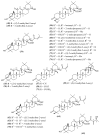
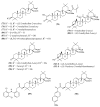

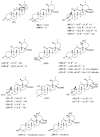


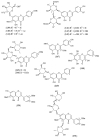

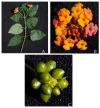


Similar articles
-
Phytochemical study of Lantana camara flowers, ecotoxicity, antioxidant, in vitro and in silico acetylcholinesterase: molecular docking, MD, and MM/GBSA calculations.J Biomol Struct Dyn. 2023 Nov;41(19):9282-9296. doi: 10.1080/07391102.2022.2141883. Epub 2022 Nov 3. J Biomol Struct Dyn. 2023. PMID: 36326114
-
Microwave and ultrasound extraction of antioxidant phenolic compounds from Lantana camara Linn. leaves: Optimization, comparative study, and FT-Orbitrap MS analysis.Phytochem Anal. 2024 Jun;35(4):889-902. doi: 10.1002/pca.3335. Epub 2024 Feb 18. Phytochem Anal. 2024. PMID: 38369344
-
Phytochemical Analysis and Antimicrobial Potential of Parthenium hysterophorous and Lantana camara.Recent Pat Biotechnol. 2025;19(3):251-259. doi: 10.2174/0118722083316748240821151703. Recent Pat Biotechnol. 2025. PMID: 39253933
-
Phytochemistry and pharmacology of the genus Drypetes: A review.J Ethnopharmacol. 2016 Aug 22;190:328-53. doi: 10.1016/j.jep.2016.06.060. Epub 2016 Jun 25. J Ethnopharmacol. 2016. PMID: 27353868 Review.
-
From an Invasive Weed to an Insecticidal Agent: Exploring the Potential of Lantana camara in Insect Management Strategies-A Review.Int J Mol Sci. 2024 Nov 28;25(23):12788. doi: 10.3390/ijms252312788. Int J Mol Sci. 2024. PMID: 39684506 Free PMC article. Review.
Cited by
-
Chemical Composition and Acaricidal Activity of Lantana camara L. Essential Oils Against Rhipicephalus microplus.Plants (Basel). 2025 Jul 29;14(15):2336. doi: 10.3390/plants14152336. Plants (Basel). 2025. PMID: 40805685 Free PMC article.
References
-
- Byng J.W., Chase M.W., Christenhusz M.J., Fay M.F., Judd W.S., Mabberley D.J. An update of the angiosperm phylogeny group classification for the orders and families of flowering plants: APG IV. Bot. J. Linn. Soc. 2016;181:1–20.
-
- WFO Plant List. Snapshots of the Taxonomy. Search for Lantana L. WFO Plant List | World Flora Online. [(accessed on 9 March 2024)]. Available online: https://wfoplantlist.org/taxon/wfo-4000020568-2023-12?page=1.
-
- Cardoso P.H., O’Leary N., Olmstead R.G., Moroni P., Thode V.A. An update of the Verbenaceae genera and species numbers. Plant Ecol. Evol. 2021;154:80–86. doi: 10.5091/plecevo.2021.1821. - DOI
-
- Babar V.B., Khapale P.R., Nagarale S.N. Preliminary investigation and in-vitro anticancer activity of Lantana camara L. (Verbenaceae) J. Pharmacogn. Phytochem. 2019;8:2524–2527.
Publication types
MeSH terms
Substances
Grants and funding
LinkOut - more resources
Full Text Sources
Molecular Biology Databases

